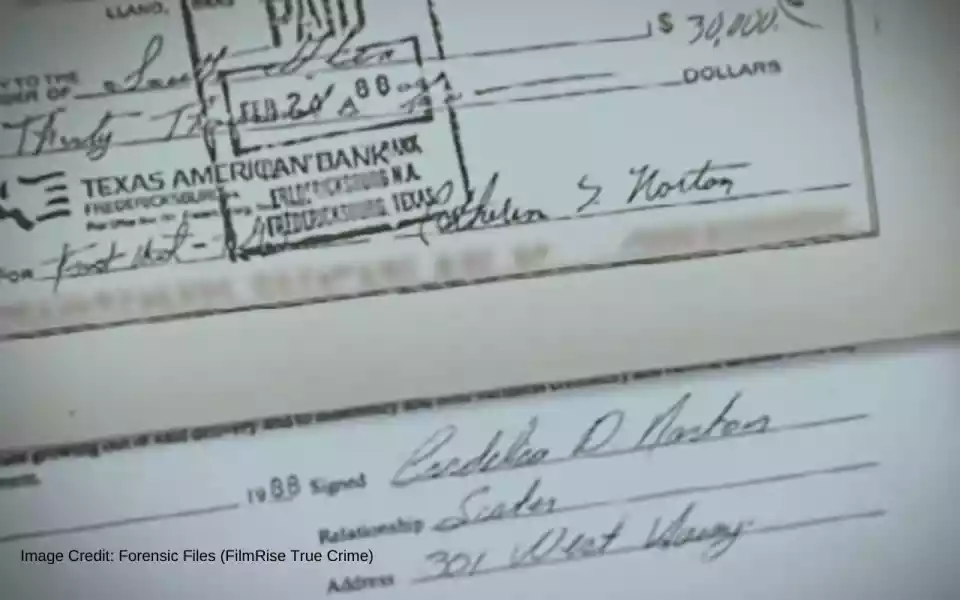How Olgie and Leita Nobles and Norton Sister Died by Tim Scoggin? (Summary of Penchant for Poison)
| Year of Incident | 1988 |
| Region and Location | San Angelo, Texas (Olgie and Leita Nobles) and Llano, Texas (Norton Sisters) |
| Forensic File Case | Penchant for Poison (Season 10, Episode 33) |
| Victims | Leita and Olgie Nobles, Catherine and Cordelia Norton |
| Culprit | Tim Scoggin (Timothy G. Scoggin) |
| Type of Crime | Homicide by poisoning and cheque fraud |
| Forensic Evidence | Arsenic in body, ashes, forged cheques, forged cremation documents. |
| Forensic Techniques | NAA, Colorimetric Analysis, Questioned Document Analysis |
| Charged For | 3 murders, 1 attempted murder, forgery, and theft |
| Punishment | Two life sentences |
| Conviction Status | Denied parole in 2020, another chance in 2025 |
| Where is Now | Wynne Unit (WY) men’s prison, Huntsville, Texas |
Olgie (70) and Leita (69) Nobles owned a well-off air conditioning business in San Angelo, Texas. In March 1988, Olgie got really sick and died. Weeks after his husband’s death, Leita started feeling nauseous and experiencing stomatic pains. Despite the initial dismissal of the doctors, she was soon hospitalized due to the paralysis of her limbs.
Upon a battery of tests, arsenic was detected in her system that was three times that of the lethal dose. Leita Nobles initially suspected her husband poisoned her. However, forensic elemental analysis of her hair revealed that she continued to consume arsenic even after her husband’s death, raising suspicions about Olgie’s death as well.
With Leita’s permission, Olgie’s body was exhumed, and lethal levels of arsenic were found in his major organs, proving his death was a homicide. Investigators searched their house and surroundings for the source of the poison and to see whether it was an accident. They found the presence of arsenic in an antacid container.
Investigators looked for the individuals who had access to Noble’s house. They found two possible suspects: one was their disabled son and the other was a family friend, Tim Scoggin who bought their business. Leita Nobles refused to doubt either of them.
Going through Tim Scoggin’s past, investigators found that he was previously linked to the wealthy sisters, Cordelia (83) and Catherine (75) Norton, in Llano, Texas. Both Norton Sisters died one day after another in February 1988 due to sudden illness. Investigators also considered the Norton Sisters’ death suspicious.

Other evidences came into play. A $30,000 cheque signed over to Tim by the Nortons was discovered to be forged. Along with the cheque, the cremation paper named under Tim a mortician linked him to Norton’s sisters. All that remained was to prove the Modus Operandi (motive of killing). But it was nearly impossible because the sisters had been cremated.

After what was a forensic breakthrough, a massive level of arsenic was detected in the ashes of older sister Cordelia. Along with the forensic evidence, the owner of a supermarket witnessed selling rat poison (containing arsenic) to Tim in a massive amounts. This led up to the arrest of Tim Scoggin.
While Tim spends his life behind bars, his surviving victim, Leita Noble, died on 27 April 2012 at the age of 93. He was buried at Lawnhaven Memorial Gardens.
Evidence Against Tim Scoggin in Poison Forensic Files Case
| S. No. | Evidence | Location |
|---|---|---|
| 1. | Arsenic in Leita’s hair | Found after she was hospitalized due to paralysis |
| 2. | Arsenic in Olgie’s body | Found in post-mortem after exhumation |
| 3. | Arsenic in Nobles’ home | Found in an antacid container in their kitchen |
| 4. | Eyewitness | Owner of the supermarket testifies that he sold Crowley’s Rat Poison to Tim |
| 5. | $30,000 cheque signed by Cordelia Norton | Deposited by Tim Scoggin days after her death |
| 6. | Cremation documents of the Norton sisters | Submitted by Tim Scoggin to the cremation house |
Forensic Analysis Used in Tim Scoggin, Nobles and Norton Sister Case
This case had some crucial toxicological evidence. The forensic techniques used are discussed below:
1. NAA of Hair Sample from Leita
In the case of heavy metal poisoning, hair and nails can be considered a timestamp of a period when the poison was consumed.
Hair grows about half an inch per month, and Leita had about three inches of long hair, giving the forensic scientists a six-month record. Her hair strands were cut into smaller pieces and tested in Neutron Activation Analysis (NAA).
NAA is sensitive to metals and is non-destructive i.e. the solid samples need not be dissolved. From different hair strand samples, an elemental profile was made that pinpoints the time period when arsenic doses were taken.
It was seen that Leita had ingested a large dose a month prior and a month after the death of her husband. This eliminates any possibility that her husband, Olgie, poisoned her. And it all falls back to Tim Scoggin.
2. Colorimetric Analysis of Norton Sisters Ashes
Metal analysis from cremated ash was unheard of before this case and would have meant a dead end to the investigation. This is because, in cremation, the human body is subject to 2,000°F heat for three hours. This destroys majorly all evidence into ashes.
But a toxicologist from the Texas Department of Public Safety and Crime Lab, Rod McCutcheon, came through with a theory.
It is theoretically known that heavy metals give a colorimetric test with acid. But it had never been done on human remains before.
Mr. McCutcheon, proposed
Test done by Rod McCutcheon: He collected the Norton Sisters’ ashes and dissolve them in sulphuric acid to destroy any organic matter. The acidic slurry was then boiled through hydrochloric acid.
Result: The ashes of Cordelia gave an intense purple-violet color indicative of a large dose of arsenic while the ashes of Catherine “Girlie” did not show much change and gave an inconclusive result.
Similar Case: Steve White & Phillip Rouss [Metal Business] Forensic Files Case Study
3. Handwriting Analysis of the $30,000 Cheque And Cremation Papers of Norton Sisters
Tim Scoggin deposited a $30,000 check signed by Cordelia Norton after the sisters’ deaths after discovering that he was not named in their will.
It was dated a few days before their death meaning the time they were gravely ill. This raised suspicions once under scrutiny. And the cheque along with the cremation papers believed to have been signed by the Nortons was sent for handwriting examination.

Tim was a close friend of the Nortons’ and was working at a mortuary. So he likely had access to their signatures, cheques, and cremation documents. The handwriting examination along with all these corroboratives information led to the conclusion that the papers were forged by Tim Scoggin in the name of the Norton sisters.
Read More: How does Forensic Linguistics help in Reading Letters and Convicting Brian Hummert?
How Norton Sisters Case changed the history of Forensic Toxicology Analysis?
Arsenic is an odorless, tasteless heavy metal that is often the poison of choice for killers. It can easily be mixed with edible substances without causing suspicions. The symptoms of arsenic can also be disguised as any naturally caused disease.
Rod McCutcheon, the toxicologist, based his experiment on the principle that even high temperatures cannot destroy heavy metals and, after the cremation, arsenic has to be present in the ashes as solid or gas.
With this theory, he went forward and made a breakthrough in the case by detecting arsenic from cremated human remains. This was never tried before and is applicable to any heavy metal like mercury and bismuth.
Read More: Purr-Fect Match [Forensic Files] Case: How Cat’s Hair Solve the Case?
Charges and Punishment for Murders by Tim Scoggin
- Tim Scoggins was found guilty and charged with three murder cases, one attempted murder, and forgery and theft. He was sentenced to two life imprisonment.
- Where is Tim Scoggin now? Tim still serving his life imprisonment at the men’s prison of Huntsville, Texas, Wynne Unit (WY).
- He applied for parole trial many times, and lastly, in 2020, his parole was refused. However, he has another chance in 2025.
Read More:
- Over a Barrel Case: Forensic File Case of Clifford and Alma Merck
- Can the Age of Paper be Determined? How to Determine? 10+ Forensic Paper Dating Techniques
- Forensic Analysis of Diatoms in Drowning: Extraction and Procedure
- E. Coli O157 Outbreak Core Evidence Forensic File Case Study

FR Author Group at ForensicReader is a team of Forensic experts and scholars having B.Sc, M.Sc, or Doctorate( Ph.D.) degrees in Forensic Science. We published on topics on fingerprints, questioned documents, forensic medicine, toxicology, physical evidence, and related case studies. Know More.

Pingback: Todd Kohlhepp [Serial Killer Case Study] #Victim, Pattern, Motive, Signature